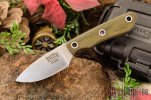- Joined
- Jun 21, 2020
- Messages
- 98
Hello everyone, hope your day is going well!
I just finished sanding my first satin blade and wanted your thoughts on it. Ways to improve, what to do different, etc.
I read after I had already heat treated the blade that it's easier to do all the hand sanding before heat treat while the steel is still soft, but it is what it is. I sanded at 120, 220, 400, 600, 800, and back to 600. The last 600 I used a block with a piece of leather glued on and sanded in one direction, pulling towards and then off the tip.
(I still haven't figured out how to attach photos on here, so heres links to the photos on dropbox)
https://www.dropbox.com/s/bdcjv27o4870dlr/Satin1.jpg?dl=0
https://www.dropbox.com/s/294wg1h98rk3s7g/Satin2.jpg?dl=0
https://www.dropbox.com/s/413flt272u008as/Satin3.jpg?dl=0
https://www.dropbox.com/s/nt38tcvcc79ntyz/Satin4.jpg?dl=0
https://www.dropbox.com/s/nntkqcfgi6xnpfy/Satin5.jpg?dl=0
I just finished sanding my first satin blade and wanted your thoughts on it. Ways to improve, what to do different, etc.
I read after I had already heat treated the blade that it's easier to do all the hand sanding before heat treat while the steel is still soft, but it is what it is. I sanded at 120, 220, 400, 600, 800, and back to 600. The last 600 I used a block with a piece of leather glued on and sanded in one direction, pulling towards and then off the tip.
(I still haven't figured out how to attach photos on here, so heres links to the photos on dropbox)
https://www.dropbox.com/s/bdcjv27o4870dlr/Satin1.jpg?dl=0
https://www.dropbox.com/s/294wg1h98rk3s7g/Satin2.jpg?dl=0
https://www.dropbox.com/s/413flt272u008as/Satin3.jpg?dl=0
https://www.dropbox.com/s/nt38tcvcc79ntyz/Satin4.jpg?dl=0
https://www.dropbox.com/s/nntkqcfgi6xnpfy/Satin5.jpg?dl=0





